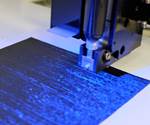Oxford Advanced Surfaces, 2-DTech to develop graphene-enabled surface treatments
Oxford’s Onto chemistry platform improves the adhesion of paints, coatings and adhesives to composite materials.

Source | Oxford Advanced Surfaces
Oxford Advanced Surfaces (OAS, Begbroke, U.K.), a pioneer and market leader in the surface treatment of polymeric, plastic and composite materials by the application of highly reactive carbene chemistry, announced on March 16 a new collaboration agreement with 2-DTech Ltd. (Manchester, U.K.) a subsidiary of Versarien plc.
The companies aim to develop a new range of products that incorporate nanomaterials, such as graphene, for integration into OAS’ Onto surface treatment chemistry platform to deliver enhanced mechanical performance and improved electrical and thermal conductivity.
OAS’s patented Onto chemistry platform is used to improve the adhesion of paints, coatings and adhesives to composite materials and engineering plastics, for applications ranging from transportation and aerospace to wind energy.
“Challenging applications for new and existing materials require innovative surface treatments; through our collaboration with 2D-Tech, we have the opportunity to develop new products by incorporating nanomaterials, such as graphene, to meet these challenges,” says Dr. Jon-Paul Griffiths, chief technology officer at Oxford Advanced Surfaces.
“We are delighted and very excited to work collaboratively with OAS; our aqueous Graphinks and OAS' aqueous-based adhesion promoters (Onto) are a natural fit and can bring about unique opportunities and markets that we haven't yet explored,” says Steve Hodge, chief technology officer at Versarien.
Related Content
-
A new era for ceramic matrix composites
CMC is expanding, with new fiber production in Europe, faster processes and higher temperature materials enabling applications for industry, hypersonics and New Space.
-
Combining multifunctional thermoplastic composites, additive manufacturing for next-gen airframe structures
The DOMMINIO project combines AFP with 3D printed gyroid cores, embedded SHM sensors and smart materials for induction-driven disassembly of parts at end of life.
-
Large-format 3D printing enables toolless, rapid production for AUVs
Dive Technologies started by 3D printing prototypes of its composite autonomous underwater vehicles, but AM became the solution for customizable, toolless production.

.jpg;width=70;height=70;mode=crop)














